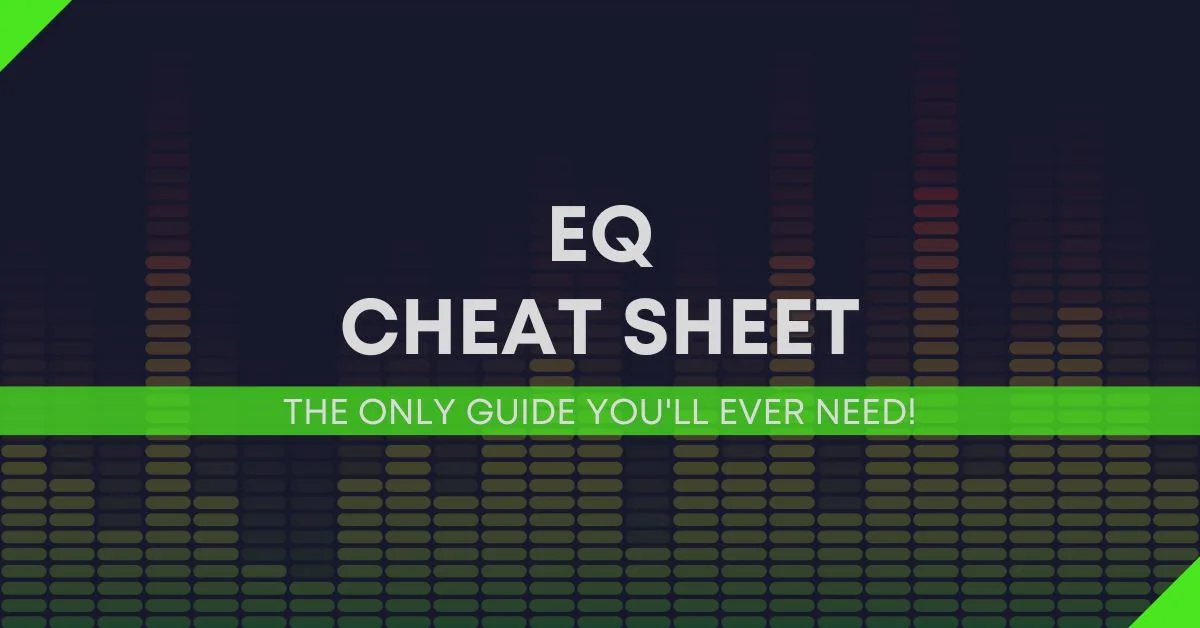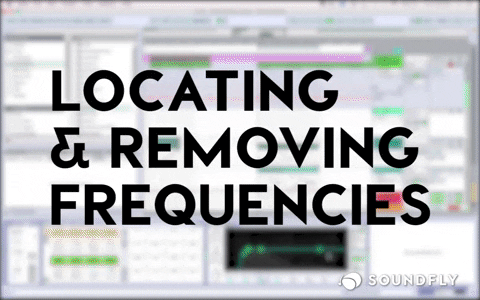
Are you worried about equalization? No need to be! Our EQ Cheat Sheet and guide will familiarize you with the best practices to get the best results.
Knowing where each instrument fits in a frequency spectrum will help you achieve mixes that stand up to commercial releases. In this article, we will demystify equalization and go over the tips and tricks of using EQ like a pro. From understanding equalization to the EQ Cheat Sheet, we'll talk about it all along with providing a detailed instrument-by-instrument guide to EQ. If you are ready to improve your audio skills then read on!

EQ in audio is the process of making changes in the balance of frequency components in an audio signal. Typically these EQ adjustments are made within the frequency spectrum of 20 Hz to 20 kHz as that is the range of human hearing. EQ is ultimately used to manipulate these frequencies to create a clear and balanced mix.
EQ can also be used to clean, enhance, or degrade a piece of audio. An engineer will make a decision on the best course of action as he or her is mixing a song. In most cases they will use it as a corrective tool but in some scenarios they will find use for it as a creative tool. EQ is the tool used to create the infamous vocal telephone effect.
Now you that you have a good idea what equalization is and its purpose, lets discuss what frequencies are and how they are created.
Frequency is a function of air vibrations. For example, when a violin’s string is plucked, it vibrates and creates rapid changes in air pressure or what we call sound waves. These sound waves are vibrations that happen over time, and the number of oscillations or sound wave cycles per second is the string’s frequency. These frequencies are measured in Hertz (Hz) or cycles per second. They determine the pitch that we end up hearing.
The human frequency hearing range is approximately 20 Hz – 20 kHz, and it differs from one person to another depending on many factors. Every musical instrument resonates within a fundamental frequency. This frequency is multiplied several times into what is known as overtones. These define its sound.
When the fundamentals and overtones are combined with percussive elements that make up the sound’s Timbre (pronounced Timber but spelled Timbre), without the overtones, the sound from a musical instrument like the piano will be unrecognizable, but with overtones, musical instruments sound like the instruments that they are.

If you have ever stood behind the soundboard in church or at a concert, the knobs on the console can seem daunting. Working the soundboard, learning how to EQ appropriately, and producing the right mix of sounds isn’t Rocket Science; it simply requires the right tool(s) and is one of the principal skills to learn in audio production.
When you closely examine modern recordings, you will notice that equalization is present on almost every track. Getting the best results from your mixes is a function of adhering to some principles; these vital principles will make EQing your tracks less complicated.
Filtering involves attenuating or removing specific frequencies from audio while allowing others to pass. Filters are typically low-pass, high-pass, and band-pass (a combination of high pass and low pass filters). The low or high frequencies are the most commonly filtered.

This involves identifying a problematic frequency and either reducing or eliminating it so that it doesn’t continually cause problems in a mix.
There are occasions recorded instruments need more shine in a mix. The act of boosting or adding to the frequency of these instruments can make them more prominent or add specific attributes to the sound source. This is called Additive EQ.
When you know what specific frequencies sound like, you will become more proficient at EQing your mixes. In this section, we will quickly examine the frequency spectrum to get you up to speed.
In most cases this is the lowest frequency range we suggest you work with for major adjustments. In this range, boosting will add fullness to bass instruments like the bass guitar, kick drum, and toms. While increasing this frequency adds more fullness, cutting it reduces the impact or boom sound of the bass. It's typical to see a boost in this range on the kick or bass in genres like dance or EDM.
Boosting here will give the lowest frequency instruments a harder sound. Increasing it will add fullness to guitars and snare, as well as warmth to the piano and horns. This is also a great frequency to look at boosting for kick and bass guitar in rock or metal genres where you don't need that deep sub-bass.
If you need to boost this frequency, it will add fullness to vocals, snare, and give your guitars a harder (thicker) sound. Reducing it decreases the muddiness of vocals or mid-range instruments and the gong sound of cymbals. WARNING: This frequency should be treated with extreme caution because it can either muddy up or thin our your sound in a negative way.
Cutting here increases the punch for kick drums. It's not uncommon to see cuts as large as 12 dB to enhance the kick drum sound. Cuts here also decreases the ambiance on cymbals. Boosting at 400Hz adds clarity to bass lines, especially when mixing on speakers at low volume or smaller speakers.
Increasing here brings out the clarity and punch of the bass line. Reducing removes the “cheap” sound of acoustic guitars. NOTE: 800 Hz - 1 kHz is where the "honky" sound lies in some instruments. If something has this unpleasant sound then this is where you want to cut.
Boost to increase the clarity and pluck of the bass guitar. Cut to reduce or remove dullness of guitars and nasal sound of vocals. NOTE: If you want that Fender Precision bass sound, do a healthy boost at 1 kHz.
Boost to add presence to vocals, more drum attack to the toms, more “finger sound” on the bass guitar. Cut to make background parts and instruments more distant, and soften “thin” guitars. NOTE: A boost here will help vocals cut through the mix but it can also make them sound harsh. You need to balance this range with the lower-mids 200-300 Hz to create a well balanced lead vocal.
Boost to add attack to percussion instruments, more punch to soft vocals, more “finger sound” on the acoustic bass. Boosting will also sharpen synthesizers, rock guitars, acoustic guitar, and piano. Cut to reduce sibilance. NOTE: You will find that a lot of de-essers default to this range.
Frequencies in this spectrum usually add air to instruments, so it is wise to avoid excessively boosting everything here. Boost to brighten vocals, increase “light brightness” in acoustic guitar and piano, hardness on cymbals. Cut here to reduce sibilance. NOTE: Be careful not to boost a lot for cymbals here. Cymbals usually already have a lot of energy in this range and a boost is typically not needed.
Related Article: What Is A High-Pass Filter And How Does It Work?

EQ cheat sheets are heavily requested amongst people out there looking to make and create their own music. So, what exactly is an EQ cheat sheet?
An EQ cheat sheet, also called an audio frequency chart or instrument frequency chart, isn’t a list of rules that you must follow; it is a guide that provides starting points and general ideas for your mixes with sounds, instruments, and vocals. It’s a graphical representation that shows you frequency responses of common instruments across the frequency range of human hearing. It gets you started, and it will help get you where you want to be more quickly.
It is important to note that not everyone is on the same page regarding EQ and that an EQ cheat sheet isn't law. It is therefore essential that you always trust your ears while using an EQ cheat sheet as a guide. Now lets get to the part you you have been all waiting for; the EQ Cheat Sheet!
In this below EQ cheat sheet and guide, you will learn our recommended approach for EQing 12 different instruments. These tips and tricks will help you achieve better mixes and results and ultimately improve your audio engineering skills. With that being said, lets look at the kick drum first.
The kick is usually the biggest drum in the drum set and produces the lowest frequencies. It has a fantastic range of possibilities for tonal shaping.
TIP: A heavy cut at 250 - 500 Hz will clear up the kick sound.
Its frequencies lie more in the mid-range.
TIP: The body of the snare is the most important. Be careful not to thin out this range or it will lose its impact.
Equalizing toms is simple; the goal is to reduce boxiness and increase thump and attack.
TIP: A solid boost using a high-shelf at 5 kHz with give the toms a nice stick hit sound that will cut through the mix.
Rack Toms
Floor Toms
Equalizing cymbals and hi-hats is pretty straightforward. Their harsh metallic sound (sometimes called the clang) is around the 200 Hz range. They mostly take up the high frequencies, so you will aim to remove unwanted muddiness and clang.
TIP: Don't over-boost the high-shelf EQ. Cymbals already have a lot of air and don't need much added above 8 kHz.
The techniques required to mix drums are usually the same for percussion.
TIP: Using a high-shelf starting around 5 kHz, with a minimal boost, will add the presence shakers and tambourines need to shine in a mix.
From a frequency perspective, the kick and the bass occupy identical sonic space; therefore, your aim should be to make them work together. You need to decide whether the kick or bass should lead the bottom end to avoid having both of them compete for space in the mix.
TIP: I like doing a large boost around 1 kHz to get the bass to cut through the mix. This works best when mixing a "real" bass as opposed to a synth bass.
Depending on the type of guitar we are working with different outcomes are desired. For Acoustic guitars we want to warm and brighten them up. For electric guitars with want to add bite.
TIP: For rock guitars, you can achieve attitude and bite with an SSL emulated EQ by simply boosting the top two EQ bands until you get the sound to your liking. Beyond that, a high-pass filter up to around 80 Hz is the only other change you need on that specific EQ model. Easy Breezy!
Acoustic
Electric
It covers a wide range of frequencies.
While the wide range of possibilities in the synth world makes it hard to generalize, you may consider the following.
Male voices are usually lower than females and are more complex in their overtones. This implies that equal attention should be given to the high end of a male vocal as a female.
TIP: I usually treat vocals the same way as electric guitars. Using an SSL emulated EQ, I modify the top 2 bands and do a high-pass up to 80 - 120 Hz.
Related Article: How To Mix Vocals: 8 Tips & Techniques For Radio Quality Tracks
A good recording is essential to a good mix; in between these steps, you need smart EQing to make a good mix great. The tips provided herein will get you started on your journey to making great tracks. Remember, nothing can replace the effort you put into practice. Keep EQing!
"Some of the links within this article are affiliate links. These links are from various companies such as Amazon. This means if you click on any of these links and purchase the item or service, I will receive an affiliate commission. This is at no cost to you and the money gets invested back into Audio Sorcerer LLC."